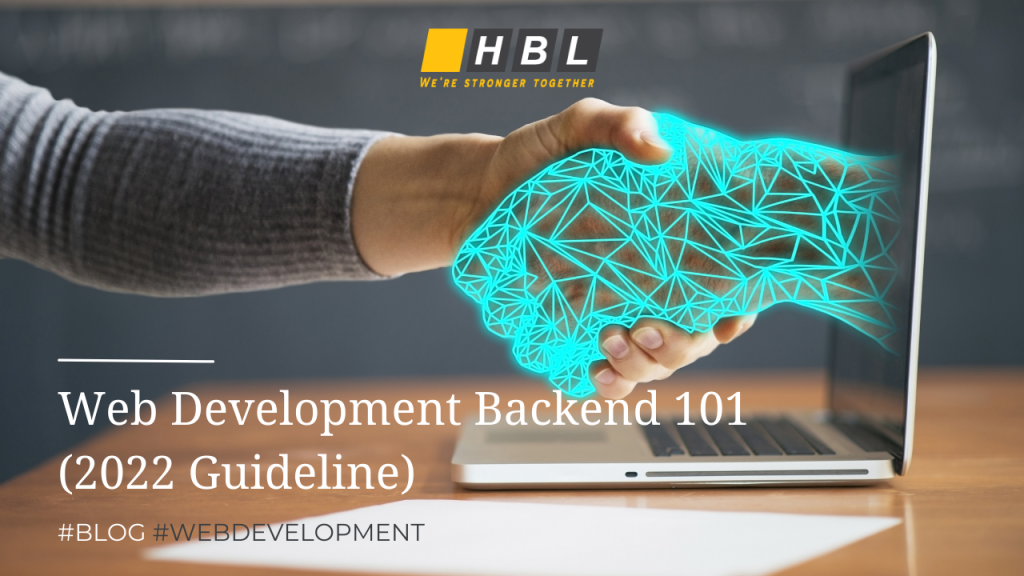You submit a contact form after you fill in your information. Have you ever questioned what occurs when you click the “Send” button? What happens to your information? Is there a system in place for collecting and analyzing data? Of course, there is! That’s what we call Backend.
Nowadays, we utilize the internet in practically all of our activities. Every part of our life has been impacted by the internet, from making reservations to having virtual meetings with people. Now, it is a one-stop resource for all knowledge and questions relating to coding, cooking, unwinding, entertainment, and much more.
With all of the technical developments, we were introduced to a brand-new industry called web development.
The two primary components of web development are web development backend and frontend. The user just sees the front end, which includes the designs and images. And all of the logic that causes things to occur is in the backend. Remember the contact form from the first example? All of the functions you performed there, such as adding data and pressing buttons, were performed on the front end, while everything that took place on the back end, such as gathering the data, processing it, encrypting it, and adding that form data to the database, was completed there.
In this article, we will discuss more about Web Development Backend and the skills required to become a backend developer.
1. Web Development Backend: What is it?
Server-side development is another name for backend development. It is everything that users cannot see and consists of background processes that take place whenever a user interacts with a website. Databases, backend logic, APIs, and servers are the main topics covered in web development backend .
Recall the example of the first paragraph. What happens when you submit your information? To give a brief overview, let’s see the following diagram:
Your information is sent to the server when you click the submit button after completing the form, where it is processed and stored in the database. But did you see any of this? No, since it took place all behind the screen. It is called the backend, as a result.
Next step, let’s talk about what backend developers are.
A backend developer is someone who uses the technology necessary to create the goods for the website’s backend. A backend developer is in charge of creating a software application’s framework.
Backend developers frequently collaborate with a team or in groups. Large teams sometimes have both frontend and backend developers who work together to create marketable products. To form a project and complete a product, backend engineers work along with frontend developers, product managers, and testers as well.
Backend programmers write the code that enables database and application communication. Backend developers are responsible for looking after and maintaining a website’s back end, which includes databases, servers, and apps. They are in charge of what you cannot see.
2. Web Development Backend vs Front-end: What are the differences?
The front end is, logically, the opposite of backend development.
The main distinction is that front-end developers construct and design the user interface, deciding how the website appears to users, whereas backend developers build how a website runs.
The basic code for processing user activities on the front end of websites and returning accurate information is laid by web development backend.
You need the back end to make the front end function, and you need the front end so that users can access and interact with the website. Neither function operates without the other.
Additionally, there are full-stack developers capable of both front-end and backend. They are the master of all crafts in the field of programming.
Read more about the difference here.
3. Which knowledge is needed for Web Development Backend?
You need to be knowledgeable about the following subjects if you want to work as a backend developer:
- Backend Programming Languages
- Databases
- Server
- APIs

3.1 Backend Programming Languages
Backend programming languages are responsible for the functionality of the website or application. They are the brains behind everything that happens on the server side. Java, Python, PHP, and .Net are the most popular backend programming languages. These languages are used by millions of developers all over the world to create robust and scalable applications.
Java
Java is a versatile and powerful programming language for web development backend, that enables developers to create robust, high-performance applications. Java is platform-independent, meaning that it can run on any operating system. It is also well-suited for developing distributed applications. Java is object-oriented, making it easy to create modular programs and reusable code.
LinkedIn, Amazon and eBay are some examples of using Java as backend programming language.
PHP
PHP is a programming language used to create dynamic web pages. It stands for “PHP: Hypertext Preprocessor”. PHP code can be embedded into HTML code, or it can be used in conjunction with various web frameworks and templating engines. PHP is a versatile language that offers many advantages. It is easy to learn, and it is possible to create sophisticated applications using PHP. PHP code is also very portable, meaning it can run on many different operating systems and web servers. Examples of popular PHP applications include WordPress, Drupal, and Joomla!.
Python
Python is a high-level, general-purpose programming language that was created by Guido Van Rossum, a Dutch computer programmer and software engineer who has been called “the Father of Python”. Python is most frequently used for developing web applications, but it can be used for a wide range of other tasks as well. Python has become increasingly popular over the past several years, and is now one of the most commonly used programming languages in the world. Python is an excellent choice for backend programming because it’s easy to learn and highly flexible. It’s also fairly easy to understand once you get started. And finally, Python is very popular among developers so there are plenty of resources available when you need them.
Ruby
The Ruby programming language is a compiled, dynamic, object-oriented programming language that has become very popular in recent years. It is easy to learn due to its concise syntax and comes with a large number of libraries that can be used for a wide range of tasks. Ruby is built on top of the Object-Oriented Programming (OOP) model, which means that it enforces the separation of data and code. This makes it easy to create complex applications without compromising performance.
Ruby is also ideal for web development backend thanks to its support for HTML5 and CSS3 features. Other advantages include its support for concurrency and the ability to handle large amounts of data.
While Ruby has many advantages, it does have some drawbacks as well. It is not as well-known as some other languages, so it may be harder to find developers who are proficient in it. Some people also feel that Ruby’s syntax is too verbose, making it difficult to read and write code.
3.2 Knowledge of Databases
A database is a structure that stores information in a computer. It can be any kind of data, such as a spreadsheet or an Excel file. A database can also contain software that lets users access and edit the information stored in the database.
In general, a database is a structured way to store data. However, there are different types of databases.
First, there are relational databases. These databases use tables to organize and store data. In addition, they can let users add, edit, and delete records in the table.
Second, there are document databases. These databases let users create documents and store them in the database.
Finally, there are NoSQL databases. These databases don’t use tables to organize and store data. Instead, they use other types of structures to store and organize data.
3.3 Knowledge of APIs
API Definition
Through the use of APIs, the entire internet works. Application Programming Interface, or API, is a channel via which software may communicate with one another.
A collection of guidelines and standards known as an API enables online communication between various customers, programs, or services. The server is the one who offers the API and the client is the one who consumes it when two systems are communicating.
Since APIs are a means of transferring data, backend developers should be well-versed in them. In most cases, APIs serve as a bridge between the databases and the backend, allowing developers to get user data. Python, NodeJS, and other languages and frameworks are used by backend developers to construct APIs. Frontend developers may then use these APIs to collect data, display it on the frontend of websites, and improve user experience.
The two most well-known abbreviations for API data are JSON (for JavaScript Object Notation) and XML (for eXtensible Markup Language).
3.4 Knowledge of Servers
Every web application that you see today runs on a remote PC called a server. On the internet, the term “server” is commonly used to refer to the computer system that receives requests for web-based files which includes HTML, CSS, Javascript, etc., and sends those files to the client.
Since servers are the most commonly used medium to deliver important services, most servers are never turned off. This part of the servers makes it an essential element for a backend developer to learn about. Some examples of the servers are Apache, Nginx, IIS servers, and Microsoft IIS.
4. Backend Developer Roles and Responsibilities
Within web development backend tasks, writing APIs, connecting with databases, building libraries, and enhancing data architecture are the main duties of a backend developer. Additional duties for a backend coder include:
- Develop server-side algorithms in collaboration with front-end programmers to effectively move data to client-side web apps.
- Work with the project manager and the QA engineers to build and improve the user experience (UX).
- Work together with the stakeholders to comprehend their specific demands, then convert those needs into technical specifications to provide the best possible technological solution.
- Enhance responsiveness and effectiveness.
- Analyze the objectives and needs, then deal with problems and mistakes.
- Use the database to exchange information.
- Organize and create APIs
- Construction architecture
- Security measures
- Writing code.
CONCLUSION
The web is rapidly changing the world. Everything we use and encounter every day has gone online. The need for backend developers and web development backend and front-end is growing along with this upswing in technology. Web development backend is a also lovely choice if you want to have an engaging and fascinating profession if you want to give your career direction.
Read more about website development?
Web Design and Web Development: 5 Main Distinctions
Corporate Website Development: The Keys To Success
Most Common Web Development Services
More about us: HBLAB JSC

